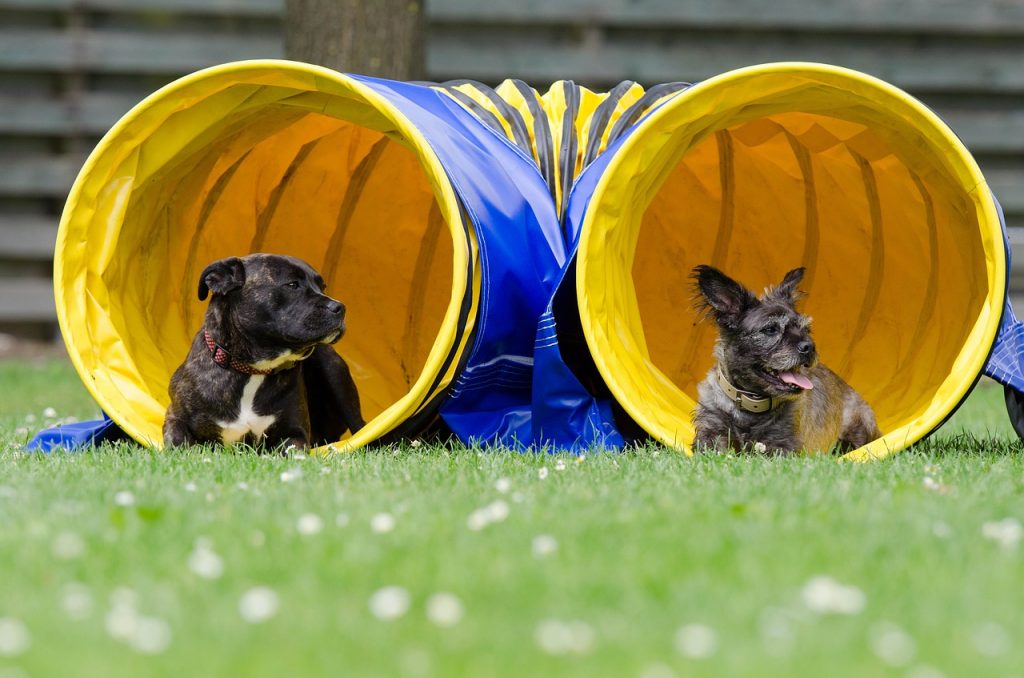Has your dog had an injury and they need an exercise rehabilitation program to safely return to normal activities?
Dog Rehabilitation 101 takes a look at the basic principles of exercise rehabilitation in dog’s. These principles can be applied to any exercise program, whether the primary purpose is rehabilitation from injury, or conditioning. For the purposes of this article we are looking at exercise programs for rehabilitation.
Program Design Basics
The success of your dog’s exercise program depends on four factors that are common in the design of any exercise program. These factors make up the FITT formula:
- Frequency: How often your dog exercises
- Intensity: How hard your dog exercises
- Timing: How long your dog exercises
- Type: The type of exercise your dog performs e.g. strength, endurance, balance.
If your dog is given an exercise rehabilitation program by a Canine Rehabilition Professional the basic program structure will include each of the aspects of the FITT formula.

Common Exercise Terms
Repetitions:
Otherwise call ‘reps’. This is the number of times an exercise is repeated continuously. Rep’s should only be counted if they’re completed in good form. The exercise should be terminated if your dog isn’t able to maintain the form.
For example, in the sit to stand exercise your dog sits squarely for the first 3 reps before starting to flare their back right leg on subsequent sits. Your dog only performed 3 reps in good form, even if you completed 5 before terminating due to poor form.
Sets:
Sets are the number of times a group of reps are repeated. e.g. 3 x 10 reps = 10 reps are performed continuously before a short rest. This is then repeated 3x.
Remember, your dog needs to complete all reps in good form. If they weren’t able to complete all of their reps in the first set then you can do one of two things. Terminate the exercise for the day. Complete a second set of as many reps in good form, even if it’s only a couple. Note this so you know the reps and sets for the next session.
Duration:
Commonly seen with endurance based exercise. Duration is a time- based activity length. E.g. 5mins of leash walking.
Similar to reps, a regression in movement or gait (e.g. increased limping) means its time to terminate the exercise for the day.
Frequency:
How many days of the week the exercises should be performed. E.g. 1-2x per day means you’ll perform the exercise 1-2x per day, every day of the week.
If an exercise should be performed 2-3x per week look to do it on alternate days so that your dog has a day’s rest between the exercises. This is important for strengthening exercises as the muscles need time to repair and grow stronger after each session.
Frequency is a goal just like reps and sets. You may need to be build towards the goal over a series of days, weeks, or months. Watch your dog’s fatigue levels.
Starting an Exercise Rehabilition Program
- Always start with in your dog’s comfort zone. If the goal is to complete 10 reps then you may start with 2-3 reps and build from there. Once the goal has been achieved the exercise can be progressed.
- Unless advised otherwise, introduce one exercise at a time. If you start several exercises at once and you have a flare, it’s harder to determine the source. E.g. sit to stand building to 10 reps daily.
- Complete strength work 3-5x per week on alternate days, or as part of a structured “split” program.
- Complete stretching and balance exercises daily unless otherwise advised.
- Avoid overtraining your dog. Rest and recovery are important components of a dog’s exercise program. If in doubt, terminate an exercise and/or take a day off.
- Don’t be afraid to contact your Canine Rehab Professional or Vet if you’re ever unsure.
Watch Out For Fatigue
Dogs hide fatigue well. Signs of fatigue include:
- Excessive panting
- Spade‐shaped tongue
- Elevated heart rate
- Drooping tail and / or ears
- Trembling muscles
- Gait changes. Look for subtle changes like a shortened stride in one or more limbs, or change from a trot to an amble or pace
- Refusal to continue
If your dog demonstrates any of these signs it is time to conclude your session.
Watch your dog get up after their next nap, and the following morning, to check they’re not stiff or sore. If so, the program may need to be adjusted (~50%).

Exercise Progression
Progression is an important part of an exercise rehabilitation program. Consider the following when trying to determine if its time to progress:
- When it’s clear that the current level of work is not difficult for your dog, the exercise can be progressed and made more demanding.
- If your dog is tired when they have completed their exercise program, but they’re ready to play 30 minutes later, its likely the exercises can be progressed.
- If your dog seems tired for the rest of the day, the current level of work should be maintained (or slightly decreased).
- If your dog is stiff or sore the next day, or hesitant to work, the intensity of the exercise should be halved and then slowly progressed.
It’s important to note that if you’re working with a Canine Rehab Professional seek their advise before progressing any exercise.
Keep Your Dog Motivated
Most dogs are very treat‐motivated. Consider the value of the food (carrot, liver, kibble, cheese, peanut butter) and use accordingly to keep your dog motivated.
Timing of the treat delivery is critical. It should be done immediately after your dog demonstrates the correct behavior. Initially, each correct behavior (or part behaviour if it’s a new skill) is rewarded. Gradually, treats can be given less often and randomly as your dog masters the skill.
For duration / holding exercises where constant attention is desired, a frozen peanut butter lick mat, mug, or treat-dispensing mat can be used. Organic peanut butter is smeared on the mat. The mat can then stored in the freezer for 1-2hrs.
When your dog is working, you can either hold or suction the mat to a wall, so that your dog can lick the mat, working continuously for the reward during an exercise. An example may be a prolonged stand on a balance disc or ball.
Remember to account for training food as part of their total daily intake – feed them less dinner or use part of their dinner for the training. This is especially true if your dog is on a weight control diet.

Conclusion
Reps, sets, frequency, and duration are terms that are synonymous with exercise rehabilition programs. Get to know what they mean and how to safely progress exercises.
Remember rehabilitation is not a rush. Only count reps in good form and don’t progress too quickly.
“If in doubt, start slowly. There is always tomorrow.”
If you would like to read more about various musculoskeletal conditions in dogs click here.
This article is not meant to replace the specific advice of your Vet or Canine Rehab Professional.

